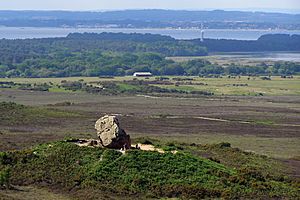Agglestone Rock facts for kids
Agglestone Rock, also known as the Devil's Anvil, is a giant block of sandstone weighing about 400 tonnes. That's like 400 small cars! It sits on top of a cone-shaped hill, about a mile from the village of Studland in south Dorset, England.
The rock used to look like an anvil (a tool with a flat top used by blacksmiths). But in 1970, it tilted over, and now its top is at a 45-degree angle.
What is the Legend of Agglestone Rock?
Local stories say that the devil himself threw this huge rock! The legend says he threw it from The Needles, which are famous rocks on the Isle of Wight. He supposedly wanted to hit either Corfe Castle, Bindon Abbey, or Salisbury Cathedral. Luckily, he missed!
The word "Aggle" in the old Dorset language means "to wobble." This might be how the rock got its name, as it looks like it could wobble on its perch.
How Was Agglestone Rock Formed?
Agglestone Rock is a leftover piece of very old, hard sandstone. Geologists call it "Agglestone Grit." Over millions of years, wind, rain, and ice (a process called erosion) slowly wore away the softer rock around it. This left the harder Agglestone Rock standing tall.
It used to have its famous anvil shape because of this natural erosion. But over time, the forces of nature continued to work on it, causing it to change shape and eventually tilt over.
Visiting Agglestone Rock
Visiting Agglestone Rock is a popular activity. The local newspaper, the Dorset Echo, even listed it as one of the "25 Things To Do In Dorset Before You Die." It's a great spot for a walk and to see a unique natural landmark.



